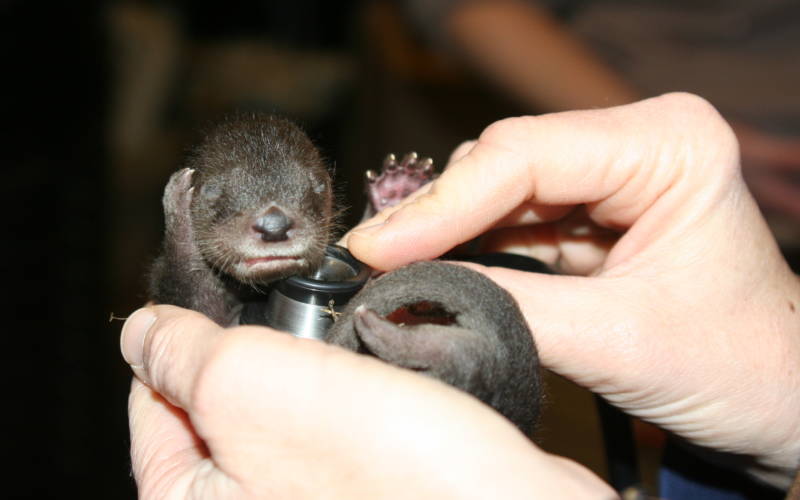Rose, an Oakland resident, will celebrate her first Mother’s Day this weekend. She’ll probably start with breakfast and a morning swim. She’ll dunk her babies underwater and wrestle them for awhile, then perhaps an afternoon nap.
Rose, a river otter at the Oakland Zoo, gave birth to three fuzzy pups in January. Her mother, Ginger, welcomed her fourth litter of pups in December. The proud father of both, resident Oakland Zoo stud Wyatt, completes the river otter family exhibit at the Wayne and Gladys Valley Children’s Zoo.
As your own mother can attest (and maybe she’s reminded you on a few occasions) babies are demanding little miracles. Newborns are nearly helpless and need constant attention. River otters are no different.
“They literally can’t do much besides find the teet and nurse,” says Margaret Rousser, zoological manager at the Oakland Zoo.
Rose doesn’t have to worry about predators, but wild river otters are making a comeback in the Bay Area, and wild otter moms have a lot to worry about. Raccoons and dogs can dig up their natal dens. And a mom needs to be sure she can get food and keep her pups warm.
In order to give their young ones the best chance at survival, river otters and other mammals have evolved a way to time their pregnancies so babies come when the habitat has ample resources for the new family.

Pregnancy’s Pause Button
Some mammal mothers can press the pause button on an embryo’s development—it’s a process called delayed implantation.
Unlike the choice human females can make to use birth control or freeze eggs to time a pregnancy, delayed implantation is unconscious. The animal mamma’s body responds to environmental cues that tell her the habitat will support her young ones. A physiological call to action: It’s go time!
Delayed implantation has some obvious benefits. Babies literally suck up tons of energy by breastfeeding. Waiting until conditions are ripe gives the baby and the mother a better chance at survival.
It helps mate selection, too. Some animals are alone most of the year; a female can go long stretches without seeing a desirable male. Delayed implantation allows her to mate when she finds a good one, and then hold onto the embryo, perhaps for months, until the timing is right for birth. If only humans were so lucky.
What Is Delayed Implantation?
Rose’s and Ginger’s pregnancies began just like your own mother’s did. The male’s sperm fused with their eggs to form a single-celled zygote. The zygote divided into a bundle of cells called a blastocyst. Here’s where human and otters diverge.
At this stage, otter development just stops. In river otters, the blastocyst can hang out in the uterus for seven to 10 months until just the right time… BOOM. An environmental signal triggers a spike in hormones that jolts the embryo back into action to implant into the uterine wall.
Rose and Ginger both mated with Wyatt last spring. About 9 months later, the handlers noticed Rose acting strange. In the wild, female otters only tolerate males during mating season. At the zoo, Wyatt, Rose and Ginger are the best of buddies but during pregnancy, instinct kicks in.
“Rose started being cranky with Wyatt,” says Rousser. “She didn’t want anything to do with him.”
Zoo staff, ready to monitor Rose’s pregnancy, wanted to be sure her embryo had actually implanted.
So they shipped Rose’s frozen poop to Cincinnati.
Reading Hormones in Otter Poop
If you’re Helen Bateman’s mail carrier, you really hope those packages are frozen, because you’re delivering a lot of poop to her lab.
Every winter, zoos from all over the country send frozen otter feces to Bateman — she’s a research associate at the Center for Conservation and Research of Endangered Wildlife at the Cincinnati Zoo & Botanical Garden. Bateman ‘reads’ the poop for a spike in progesterone, the hormone that tells her when implantation occurred.
“For a lot of carnivores, it’s in the poop,” she says, adding that it’s difficult to get urine samples from water-loving otters. “They’re not so good at peeing on cue.”
Bateman gives the zoos a 10-day window for the birth. River otters are predictable— they give birth 63 to 74 days after implantation.
A Scientific Mystery
Delayed implantation pops up across the mammal spectrum, including in species of marsupials, rodents, and mustelids, like river otters. But we still don’t know exactly how it works.
Most of what we do know is from experiments on the mink, courtesy of the fur coat industry, Bateman says. These experiments show that seasonal light cues trigger implantation. This makes sense—at high latitudes, longer days signal the passing of winter. As the snow melts, a mink mother has access to the nutrition she needs to grow a healthy pup.
Day length also seems to be a trigger for polar bears. For some bats and seals, rainfall and temperature seem to be other factors in implantation. There’s also a genetic component. Probably, it’s a mix of all of these.
For endangered species populations researchers are trying to breed in captivity such as polar bears and giant pandas, delayed implantation makes the process complicated, Bateman says.
She points out that scientists can’t manipulate endangered species to test what works best.
Scientists think that the widespread existence of delayed implantation in mammals is evidence that a common ancestor of all mammals was probably a delayed implanter. As evolutionary branches diverged over millions of years, groups dropped the trait.
So actually, humans might be the strange ones. Our ancestor lost the ability long ago.